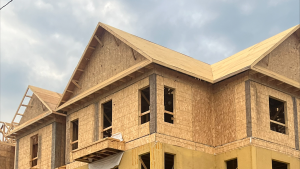With the passage of years, more and more heritage buildings in Quebec City are ending up in dire need of restoration, ravaged by the bitter cold of winter and endless freeze-and-thaw cycles of Canadian weather. However, the number of craftspeople capable of restoring them is limited.
The Conseil des métiers d’art du Québec (CMAQ) is taking aim at the problem by offering an intensive 15-week training program for stonemasons and carpenters in partnership with the College of General and Vocational Education in Montreal.
The training was developed because clients and architects were looking for a trained workforce who could work on such projects. There are presently only about 400 trained craftspeople in the entire province who are considered to be skilled enough to do the sensitive work.
“There are few people who have mastered traditional techniques,” says France Girard, project manager in architecture and heritage at the CMAQ. “Traditional techniques are little or no longer taught.
“This training is a specialization on interventions in restoration of built heritage. It is therefore aimed at customers who already have a profession but who want to specialize in the restoration of built heritage.”
The program started in late-January and is a first for Quebec. It’s a pilot taking place over four months. Students receive 270 hours of training and will be taught best practices in restoration by qualified experts. The first trainees include five carpenters and cabinetmakers as well as four stonemasons.
Students will also learn how to assess a heritage building and determine the right intervention for a project, depending on the time of construction of a building and its architectural style. Eventually, students will be able to get a 500-hour college study certificate in heritage restoration.
The CMAQ offers short-term tailor-made training courses to help artisans develop specific expertise, but for a number of years the community has been calling for a structured and longer-term training program to help ensure heritage buildings receive quality fixes.
“This training is developed following repeated requests from work providers, architects, etcetera, who want to rely on a specialized workforce that can intervene adequately on the built heritage,” explains Girard.
The course dovetails with the 2018-2023 Governmental Action Plan for Quebec Culture that recommended a training program be developed to ensure know-how related to the built heritage of the province is passed on.
Girard says the course is important because the approaches and good practices in conservation and restoration as well as the traditional methods essential to interventions on heritage buildings are not taught and there are more and more old buildings that need to be worked on.
“The construction methods of the time are different from the construction methods of today,” she says. “To work on an 18th century building, for example, you have to be able to recognize the time of its construction, its architectural characteristics, the way it was built and the materials used at the time, to preserve the integrity of the building and carry out authentic interventions.
“It is also necessary to know the various international charters on the conservation and restoration of monuments and sites which will guide good practices, and the most judicious intervention choices for the conservation of our built heritage.”
Students will learn partly online and partly in person, as some of the work just can’t be done virtually. For common skills, the courses are online. For the courses in the lab and a workshop, the training takes place in areas that can accommodate craftsmen while respecting COVID-19 guidelines.
The training program is divided into five separate courses. Four of the five courses are 45 hours each and one is 90 hours in duration.
In the first course, trainees are taught good conservation and restoration practices. They examine the types of tasks, skills and attitudes that are required in restoring a heritage building, and also learn about different conservation restoration strategies for a variety of situations.
In the second course, also 45 hours, they learn how to characterize a heritage building and its specific elements and research the cultural and social significance of a building. They also receive instruction in recognizing architectural parameters and construction methods and analyze the evolution of a building or an element.
The third course is devoted mainly to designing technical drawings related to built heritage.
Students analyze and determine the materials, techniques and tools used in a structure and learn about the manufacturing processes of the time. They’re also taught how to perform technical tests for restoring broken elements and reproducing missing elements. Finally, they learn how to do technical finishing tests.
In the final course, students carry out an intervention and restoration of an element of a real heritage structure.
The courses are taught by craftsmen who are experts in their profession, such as emeritus cabinetmaker and heritage consultant Alain Lachance, and stonemason Alexandre Maquet. For general skills courses, the trainers are architects, and a restorer from the Centre de conservation du Québec.











Recent Comments